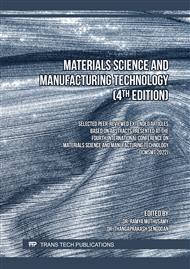[1]
L. A. Teran et al., Analysis of economic impact from erosive wear by hard particles in a run-of-the-river hydroelectric plant,, Energy, vol. 113, p.1188–1201, (2016).
DOI: 10.1016/j.energy.2016.07.072
Google Scholar
[2]
L. A. Teran et al., Failure analysis of a run-of-the-river hydroelectric power plant,, Eng. Fail. Anal., vol. 68, no. December 2014, p.87–100, (2016).
Google Scholar
[3]
P. P. Gohil and R. P. Saini, Coalesced effect of cavitation and silt erosion in hydro turbines - A review,, Renew. Sustain. Energy Rev., vol. 33, p.280–289, (2014).
DOI: 10.1016/j.rser.2014.01.075
Google Scholar
[4]
R. kumar and S. K. Singal, Operation and Maintenance Problems in Hydro Turbine Material in Small Hydro Power Plant,, Mater. Today Proc., vol. 2, no. 4–5, p.2323–2331, (2015).
DOI: 10.1016/j.matpr.2015.07.284
Google Scholar
[5]
V. K. Singh and S. K. Singal, Operation of hydro power plants-a review,, Renew. Sustain. Energy Rev., vol. 69, no. August 2016, p.610–619, (2017).
Google Scholar
[6]
C. P. Jawahar and P. A. Michael, A review on turbines for micro hydro power plant,, Renew. Sustain. Energy Rev., vol. 72, no. October 2015, p.882–887, (2017).
DOI: 10.1016/j.rser.2017.01.133
Google Scholar
[7]
G. O. Barrionuevo, B. A. Guerrero, and M. Walczak, Computational Fracture Mechanics: Evaluation of the Structural Integrity in a Penstock Applying the BS7910 Standard and Finite Element Analysis,, IOP Conf. Ser. Mater. Sci. Eng., vol. 925, no. 1, (2020).
DOI: 10.1088/1757-899x/925/1/012023
Google Scholar
[8]
X. Liu, Y. Luo, and Z. Wang, A review on fatigue damage mechanism in hydro turbines,, Renew. Sustain. Energy Rev., vol. 54, p.1–14, (2016).
Google Scholar
[9]
P. J. Dunstan and S. C. Li, Cavitation enhancement of silt erosion: Numerical studies,, Wear, vol. 268, no. 7–8, p.946–954, (2010).
DOI: 10.1016/j.wear.2009.12.036
Google Scholar
[10]
B. S. Thapa, B. Thapa, and O. G. Dahlhaug, Current research in hydraulic turbines for handling sediments,, Energy, vol. 47, no. 1, p.62–69, (2012).
DOI: 10.1016/j.energy.2012.05.014
Google Scholar
[11]
R. Ahmed and M. Hadfield, Mechanisms of fatigue failure in thermal spray coatings,, J. Therm. Spray Technol., vol. 11, no. 3, p.333–349, (2002).
DOI: 10.1361/105996302770348727
Google Scholar
[12]
A. HAMILTON, A. SHARMA, and U. PANDEL, SOLID PARTICLE EROSION RESISTANCE OF HVAF-SPRAYED WC-10Co-4Cr COATING ON CA6NM STEEL,, Surf. Rev. Lett., vol. 24, no. Supp01, p.1850011, (2017).
DOI: 10.1142/s0218625x18500117
Google Scholar
[13]
B. S. Mann and V. Arya, Abrasive and erosive wear characteristics of plasma nitriding and HVOF coatings: Their application in hydro turbines,, Wear, vol. 249, no. 5–6, p.354–360, (2001).
DOI: 10.1016/s0043-1648(01)00537-3
Google Scholar
[14]
L. Thakur, N. Arora, R. Jayaganthan, and R. Sood, An investigation on erosion behavior of HVOF sprayed WC-CoCr coatings,, Appl. Surf. Sci., vol. 258, no. 3, p.1225–1234, (2011).
DOI: 10.1016/j.apsusc.2011.09.079
Google Scholar
[15]
J. Y. Yu, D. W. Shi, Z. Li, S. Y. Yu, and Y. Zhang, Experimental study on repairing large modulus rack cracks by argon arc welding,, Mater. Sci. Forum, vol. 943 MSF, p.8–13, (2018).
DOI: 10.4028/www.scientific.net/msf.943.8
Google Scholar
[16]
R. De Paula Silva, M. I. S. T. Faria, L. F. C. B. De Almeida, C. A. Nunes, D. Vieira, and W. Borges, Microstructure and mechanical properties of ASTM A743 CA6NM steel welded by FCAW process,, Mater. Res., vol. 20, no. 6, p.1622–1629, (2017).
DOI: 10.1590/1980-5373-mr-2017-0468
Google Scholar
[17]
G. O. Barrionuevo, S. Ríos, S. W. Williams, and J. A. Ramos-Grez, Comparative Evaluation of Machine Learning Regressors for the Layer Geometry Prediction in Wire arc Additive manufacturing,, in 12th International Conference on Mechanical and Intelligent Manufacturing Technologies, 2021, p.186–190.
DOI: 10.1109/icmimt52186.2021.9476168
Google Scholar
[18]
M. Karmuhilan and A. K. Sood, Intelligent process model for bead geometry prediction in WAAM,, Mater. Today Proc., vol. 5, no. 11, p.24005–24013, (2018).
DOI: 10.1016/j.matpr.2018.10.193
Google Scholar
[19]
J. Liu, Y. Xu, Y. Ge, Z. Hou, and S. Chen, Wire and arc additive manufacturing of metal components: a review of recent research developments,, Int. J. Adv. Manuf. Technol., vol. 111, no. 1–2, p.149–198, (2020).
DOI: 10.1007/s00170-020-05966-8
Google Scholar
[20]
J. L. Z. Li, M. R. Alkahari, N. A. B. Rosli, R. Hasan, M. N. Sudin, and F. R. Ramli, Review of wire arc additive manufacturing for 3d metal printing,, Int. J. Autom. Technol., vol. 13, no. 3, p.346–353, (2019).
DOI: 10.20965/ijat.2019.p0346
Google Scholar
[21]
J. Xiong, Z. Yin, and W. Zhang, Closed-loop control of variable layer width for thin-walled parts in wire and arc additive manufacturing,, J. Mater. Process. Technol., vol. 233, p.100–106, (2016).
DOI: 10.1016/j.jmatprotec.2016.02.021
Google Scholar
[22]
G. O. Barrionuevo, P. M. Sequeira-Almeida, S. Ríos, J. A. Ramos-Grez, and S. W. Williams, A machine learning approach for the prediction of melting efficiency in wire arc additive manufacturing,, Int. J. Adv. Manuf. Technol., no. 0123456789, (2022).
DOI: 10.1007/s00170-022-08966-y
Google Scholar
[23]
J.-H. Lee, C.-M. Lee, and D.-H. Kim, Repair of damaged parts using wire arc additive manufacturing in machine tools,, J. Mater. Res. Technol., vol. 16, p.13–24, (2022).
DOI: 10.1016/j.jmrt.2021.11.156
Google Scholar
[24]
S. M. Yusuf and N. Gao, Influence of energy density on metallurgy and properties in metal additive manufacturing,, Mater. Sci. Technol. (United Kingdom), vol. 33, no. 11, p.1269–1289, (2017).
DOI: 10.1080/02670836.2017.1289444
Google Scholar



